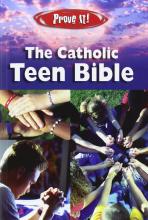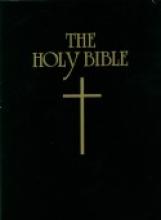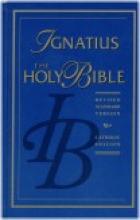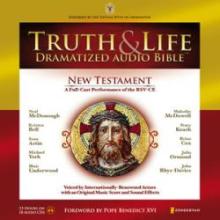Family Bibles
New American Bible with Revised New Testament and Revised Psalms
Copyrights 1970 - Old Testament, 1986 - New Testament, 1991 - Psalms
The Imprimatur was granted before the Holy See found portions of the text to be defective.
Prove It! The Catholic Teen Bible
New American Bible Translation (copyright 1970-1991)
Also contains seven full-color multipage inserts.
This Bible offers a creative and colorful format to help encourage teens to read the real text of the Bible. It is a real, complete Bible with inserts tucked in between the text. The full-color, glossy inserts run from eight to sixteen pages in length (a total of sixty pages). These inserts highlight and discuss important topics of the faith while continually encouraging the reader to do further study within the Bible itself (with lots of specific Bible references to help facilitate that). The text of these inserts is meaty, but easy to understand. The layout is attractive and contemporary, combining images of Christ and the Saints with photos of modern teens. You can see that the author has aimed at appealing to the best in teens by helping them make sense out of the Catholic faith.
The introductory insert offers some tips for getting started and a table of contents for the insert sections.
The first insert, "God; How do I know God exists?", explores the topic of basic Christian belief through scripture, tradition and reason (logic). This segment also explores the topics of: "Who is God?", "What is the Trinity?", "One God?", Consequences of the existence of God, "Why do people suffer?", and "Made in God's image."
The second insert, "Jesus" covers questions and the basic facts about the Life of Christ. This segment grapples with the following topics: "Who is Jesus?", "Can I trust the gospels?", "What did Jesus do?", "What's a miracle?", "Mary, Mother of God", "Jesus died for my sins. What does that mean?", "Jesus was a great teacher. Can't I just believe that?", "The Resurrection", "If Jesus is Lord, then...", and "When will Jesus come again - and how?"
The third insert is on the Church. This covers "What is the Church?", What does Jesus have to do with the Church?", "How can the Church be holy when it has sinners in it?", "What is the Church for?", "The Sacraments: Meeting Jesus", "Can People who aren't Catholic be saved?", "If Jesus is present in the Church, then..." the basics of what it means to be a Caholic (attending Mass, receiving the Sacrament of Reconciliation, etc.)
The fourth insert covers the topic of prayer, including "What is prayer?", "Great Moments in Prayer", "Different forms of prayer", "Learning to Pray", "Doesn't God already know how I feel?", "What should I feel when I pray?", "Why pray to saints?", "Does God answer prayers?", "I should trust prayers that have helped others draw closer to God."
The fifth section is entitled "You". This segment very cleverly handles topics involving: the Sancity of Life, Vocations, the Sanctity of Marriage, the Commandments and Beatitudes, Spiritual and Corporal Works of Mercy, and more.
The final section, "The Map" outlines the guidelines the Church gives us to follow Christ and keep his laws. It covers the Commandments, the Virtues, Gifts of the Holy Spirit, Fruits of the Holy Spirit, "Wrong Turns", the Four Last Things and prayers, including the Stations of the Cross and directions for saying the Rosary.
This book offers a very creative concept for encouraging teens who wouldn't ordinarily be drawn toward reading the Bible into picking it up and at the same time delving deeper into their Catholic faith. The one real downside is the translation. Although the New American Bible translation is commonly used at Mass throughout the United States (and it is not overtly evil!), it is reputed to have subtle inaccuracies that can distort or confuse the meaning of certain passages. However, as Catholic Answers succinctly put it, "So, which Bible is the best? Perhaps the best answer is this: The one you'll read." Keeping that in mind, I think this Bible would make an excellent Confirmation present for teenagers in your life - particularly those who have very little experience with the Bible and/or their faith in general. Homeschool students may also enjoy using this book to explore the Bible on their own. My own 11 year old daughter is eager to get her hands on my copy as soon as this review is complete. :) It would be best if this isn't the only translation studied, but it doesn't seem like a bad place to start.
The updated 2011 edition, ISBN 9781592761951, uses the NABRE version. We have concerns about this translation: please see our separate review of the revised NAB version here.
The Holy Bible: Douay Rheims Version
The Douay Rheims Bible is supposed to be the most accurate, Catholic, translation of the Bible available in the English language. The Old Testament was translated into English in 1609 and the New Testament in 1582 and revised in its entirety (and "diligently] compared with the Latin Vulgate") by Bishop Richard Challoner from 1749-1752. Although the some of the language would be considered archaic today (lots of "thees" and "thous") but it really is beautiful. Although you will probably want a more modern translation as well, the Douay Rheims is especially good for memorizing passages and as a reference for points (and discussions) in which accuracy is especially important. TAN Books also publishes the Douay New Testament in a less expensive edition.
Sample passages: Genesis 1:1-3In the beginning God created heaven, and earth. And the earth was void and empty, and darkness was upon the face of the deep; and the spirit of God moved over the waters. And God said: Be light made. And light was made.
Psalm 26: 1-2The Lord is my light and my salvation, whom shall I fear? The Lord is the protector of my life: of whom shall I be afraid? Whilst the wicked draw near against me, to eat my flesh. My enemies that trouble me, have themselves been weakened, and have fallen.
John 1: 1-5In the beginning was the Word, and the Word was with God, and the Word was God. The same was in the beginning with God. All things were made by him: and without him was made nothing that was made. In him was life, and the life was the light of men. And the light shineth in darkness, and the darkness did not comprehend it.
Imprimatur 1899
The Ignatius Bible
This is the best translation available in "modern" English (without the "thees" and "thous" found in the Douay Rheims translation). For many of us today, this language is more familiar and comfortable and is probably easier for small children to understand. We use both translations in our home and find this one a little better for reading aloud to the family. It does not contain the "feminized language" (a.k.a. "inclusive language") found in most of the modern translations of the Holy Bible. The feminized language found in most modern translations affects not only the beauty of the language, but even the subtle meanings of passages such as some Psalms where the "he" or "him" actually refers to Our Lord.
Sample Passages: Genesis 1: 1-3In the beginning God created the heavens and the earth. The earth was without form and void, and darkness was upon the face of the deep; and the Spirit of God was moving over the face of the waters. And God said, "Let there be light"; and there was light.
Psalm 27 (26): 1-2The Lord is my light and my salvation; whom shall I fear? The Lord is the stronghold of my life; of whom shall I be afraid? When evildoers assail me, uttering slanders against me, my adversaries and foes, they shall stumble and fall.
John 1: 1-5In the beginning was the Word, and the Word was with God, and the Word was God. He was in the beginning with God; all things were made through him, and without him was not anything made that was made. In him was life, and the life was the light of men. The light shines in the darkness, and the darkness has not overcome it.
Also available in softcover
Old Testament - 1005 pages, New Testament - 250 pages
Imprimatur 1966
Truth and Life Dramatized Audio Bible - New Testament
This is a beautifully-performed, professionally produced complete dramatization of the New Testament in the renowned Revised Standard Version, Catholic Edition (sometimes referred to as the Ignatius Bible). John Rhys-Davies (who plays Gimli in Peter Jackson's Lord of the Rings films) as narrator leads a great cast that includes Neal McDonough (Minority Report, Band of Brothers) as Jesus, Julia Ormond (Sabrina, First Knight) as Mary, Sean Astin (Sam in Peter Jackson's Lord of the Rings) as Matthew and Michael York (Jesus of Nazareth, Murder on the Orient Express) as Luke.
There was a time, not long ago, when such beautiful biblical resources for families were only found with the Protestant versions of the Bible. Happily that is no longer the case!
You can listen to free audio samples at the Ignatius Press website: Truth and Life Dramatized Audio Bible. This resource can be ordered on 18 CDs from many bookstores or it can be ordered as an audio download through Audible.com. Ignatius Press offers this in a special package that includes a bonus audio CD from Steve Ray (from the Footprints of God Series) on the Gospel of St. John.





